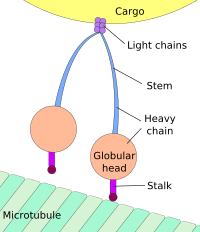
Photo from wikipedia
Stationary clusters of vesicles are a prominent feature of axonal transport, but little is known about their physiological and functional relevance to axonal transport. We investigate the role of vesicle… Click to show full abstract
Stationary clusters of vesicles are a prominent feature of axonal transport, but little is known about their physiological and functional relevance to axonal transport. We investigate the role of vesicle motility characteristics in modulating the formation and lifetimes of such stationary clusters, and their effect on cargo flow. We develop a simulation model describing key features of axonal cargo transport, benchmarking the model against experiments in the Posterior Lateral Mechanosensory (PLM) neurons of C. elegans. Our simulations include multiple microtubule tracks, varied cargo motion states and accounts for dynamic cargo-cargo interactions. Our model also incorporates static obstacles to vesicle transport in the form of microtubule ends, stalled vesicles, and stationary mitochondria. We demonstrate, both in simulations and in an experimental system, that a reduction in reversal rates is associated with a higher proportion of long-lived stationary vesicle clusters and reduced net anterograde transport. Our simulations support the view that stationary clusters function as dynamic reservoirs of cargo vesicles, and reversals aid cargo in navigating obstacles and regulate cargo transport by modulating the proportion of stationary vesicle clusters along the neuronal process.
Journal Title: Journal of cell science
Year Published: 2023
Link to full text (if available)
Share on Social Media: Sign Up to like & get
recommendations!